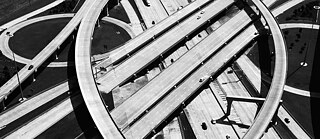Benjamin Steininger Curves and Concrete

When driving down the Autobahn, have you ever give any thought to the chemistry of gravel or the mechanics of earth? Or considered the art of curve design? No? Then it’s high time you did, because we all know far too little about the Autobahn, yet it knows a great deal about us. That’s going to change right now, so enjoy our deep dive with Benjamin Steininger into the mysteries of the Autobahn, its curves and its road surfaces.
There are some things that we take so much for granted that we cannot grasp that they are in fact too complicated for us to understand. The Autobahn is one such “thing”. And it’s not even just a question of the burden it obviously poses from an ecological or political-historical viewpoint. Though we know that the Nazis didn’t actually invent these “pyramids of the Third Reich” – to quote the title of Rainer Stommer’s now historic book – they did build a lot of them. And with their plans to use the Autobahn as an explicit mise en scene for the “landscape”, they determined not only traffic decisions but also realms of experience for decades. This is however just one element of a complication that has impact even in its less striking aspects.Autobahn, who art thou?
As a matter of fact, this construction, which is thousands of kilometres long in Germany and much longer still in many other countries, is in quite practical terms one of the most complicated “things” one will ever come into contact with in everyday life. And that’s precisely where the problems begin – after all, one doesn’t “come into contact” with it when whizzing along at 140 kilometres an hour, and even in a traffic jam one isn’t allowed to get out of one’s vehicle. And then there is the question of where the Autobahn in fact begins, and where it ends. What exactly is the Autobahn? Is it only the normally four- or six-lane structure made of asphalt or concrete that can be recognized in Germany by its blue-and-white road signs? Or can it also refer to dual carriageways, which for bureaucratic rather than technical reasons have yellow-and-black signposts, and if so, would the access roads and possibly even the tarmacked car park also count?And when one says the word “Autobahn”, shouldn’t one also mean the petrol stations that belong to it, not to mention the associated refineries, oil tankers and drilling platforms? And what about the navigation systems, route planners, satellites and computer centres that let us know precisely where there is congestion and which alternative route makes best sense?
Nothing would function without the Autobahn.
Fragments of asphalt
Even the seemingly simplest, almost banal object – the carriageway in the landscape, the layer of concrete or asphalt alongside dirty and dried-out grass – can be interpreted as an astonishingly complex thing if one gets close enough to it and if it is understood within its networks. If classical archaeologists are able to reconstruct entire trade networks and cultures from individual fragments because a particular type of glaze at a particular location points to other sites and techniques, and if paleoanthropologists can determine European migratory flows and social structures from the minerals they find in bones or teeth, what then do the kilometre-long “fragments” of asphalt and concrete reveal? Which techniques and bodies of scientific knowledge, and indeed which geographies, politics and perhaps even worldviews could be determined here?The art of curves
One thing is clear, a carriageway does not stand alone. It is merely one constituent part of a “machine”, as it is known in technology and media theory, that comprises at least two technical components, namely a wheel and a carriageway. In the case of railways, it is obvious that the steel wheels and steel railway tracks form a technically closed structure. By contrast, the Autobahn is only a closed system if nobody drives beyond the edge of the carriageway. Rubber tyres and the concrete road are perfectly matched technical components that allow vehicles to travel along the Autobahn at high speeds, yet this is only possible if the person at the steering wheel likewise functions as part of the machine.Future archaeologists will be able to determine from the radii of the curves and the gradients of the carriageway that this was not intended as a broad footpath but rather something almost akin to a track for low-flying vehicles, a structure for superhuman speeds achievable only by machines, and they will be able to deduce the amount of energy individuals were able to expend here. It will also be possible to tell from the design of the curves that the visual capabilities and reaction times of the humans at the wheel had to be factored in when planning the roads.
Smoothness is the goal.
The asphalt or concrete construction thus documents, by dint of its mere position in the landscape, not only certain mathematical insights but also a kind of theory of perception about how we control our own movement in an automobile. The design of the carriageway becomes an instrument of technical control. Because however the corset precisely follows the movements we control ourselves, we are unaware of it.
The secret of concrete
The materials out of which the road is made involve different bodies of knowledge. Concrete and asphalt are by no means natural or easily produced materials. Their production entails hardly any less industrial complexity than that of those far more obvious icons of motorization – automobiles themselves. Above and beyond the raw materials and energy sources, imported from every part of the Earth’s crust, that are needed to produce the asphalt and concrete, a bizarre planetary network spanning both geographical space and geohistorical time is present wherever concrete or asphalt is to be found in a field or section of forest. In a sense, the high temperatures of industrialization, which can only be achieved by burning coal, were already incorporated into the very first cement products of the nineteenth century.Welcome to the petromodernity
In the “petromodernity” – that period of the modern age that began in 1900 and saw oil and then natural gas raise all existing dynamics into a whole new orbit – that is to say when even higher-grade energy sources became available, the petroleum-based product that is asphalt became a mass-produced and inexpensive building material, as did concrete, which is likewise produced using fossil energy.Beware, for experts only: gravel
It is not only dull fossil energy that is present in materials like concrete, however. In terms of the history of knowledge, cement is one of the earliest applications of the high-tech methods of electron microscopy. To this day, this everyday material, which on the one hand is used almost indiscriminately, is at the same time the subject of complex research in the overlapping fields of chemistry, mineralogy, physics and engineering. It is incredibly difficult to understand the materiality of gravel and cement, of these materials that are used to pave over the landscape. And one needs to understand a lot about the margins of technology, about the chemistry of gravel and the mechanics of earth and groundwater in order to be able to build a carriageway that will serve as a secure counterpart to vehicles that are constantly subjected to technical inspections and crash tests.It was only as a result of mistakes made when roads were built into the landscape that the subject of soil mechanics emerged in the USA in the 1920s. And even today, concrete engineers involuntarily learn a lot about their material when carriageways crack in the summer, freeze in the winter or buckle because the wrong gravel from the wrong Alpine valley was used. Technology only works because it gives precise and careful consideration to the intractable material that is “the landscape”, in other words.
A carriageway planned in accordance with the principle of automotive movement must thus satisfy two very different requirements: it must glide smoothly across soils and even in its curves must not “judder” on the “screen” that is the windscreen.
It is typical of the petromodernity that new materialities have not only led to technologies and infrastructures but have also produced new knowledge, perceptions and subjectivities, for individuals and societies alike. The fossil fuels and materials of the modern age thus have more than just material impact, they also have abstract impact. This applies also to the Autobahn. That the carriageway, being the point of technical intersection between soils, vehicles and individuals, and between landscapes and steering movements, “knows” a great deal about both sides, and that we know very little about it because we do not happen to have any contact with the carriageway while hurtling along it as parts of a machine, should make us think.


